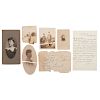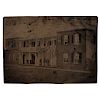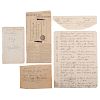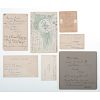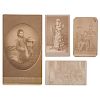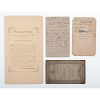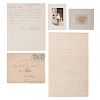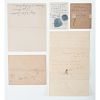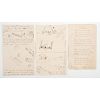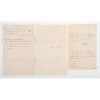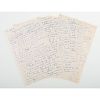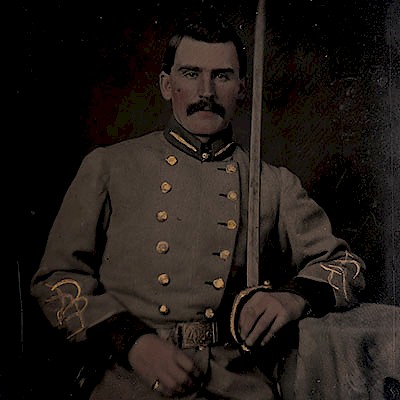Indian Wars-Era Photographic and Manuscript Archive Collected by General Owen Jay Sweet's Daughter, Marie Sweet Baker
About Seller
6270 Este Ave.
Cincinnati , OH 45232
United States
With offices in Cincinnati, Cleveland and Denver, Cowan’s holds over 40 auctions each year, with annual sales exceeding $16M. We reach buyers around the globe, and take pride in our reputation for integrity, customer service and great results. A full-service house, Cowan’s Auctions specializes in Am...Read more
Two ways to bid:
- Leave a max absentee bid and the platform will bid on your behalf up to your maximum bid during the live auction.
- Bid live during the auction and your bids will be submitted real-time to the auctioneer.
Bid Increments
| Price | Bid Increment |
|---|---|
| $0 | $25 |
| $500 | $50 |
| $1,000 | $100 |
| $2,000 | $250 |
| $5,000 | $500 |
| $10,000 | $1,000 |
| $20,000 | $2,500 |
| $50,000 | $5,000 |
| $100,000 | $10,000 |
About Auction
Jun 22, 2018
Cowan’s American History: Premier Auction, scheduled for June 22, 2018 is comprised of early photographs, documents, manuscripts, broadsides, flags, and more dating from the Revolutionary War, the Civil War, Late Indian Wars, World War I and II and beyond. Cowan's Auctions dawnie@cowans.com
- Lot Description
An exceptional Indian Wars-era collection of over 100 photographs, manuscripts, covers, newspaper clippings, and other items related to Brigadier General Owen Jay Sweet, and collected by his daughter, Marie Sweet Baker.
Owen Jay Sweet (1845-1928) was born in Connecticut, though little else is known about his early life. As the Civil War got underway, he enlisted as a second lieutenant at Binghamton, New York, and was commissioned into Company B of the 137th New York Volunteer Infantry on September 6, 1862. During the war, Sweet received promotions to first lieutenant and captain, in February of 1862 and May of 1863, respectively, and saw action at battles including Fredericksburg, Chancellorsville, and Gettysburg. He also participated in General Sherman's Atlanta Campaign, his March to the Sea, and his Campaign of the Carolinas. After the Civil War, Sweet continued in his military career by joining the regular army, and was appointed a second lieutenant in the 40th United States Infantry in May of 1867. Sweet thus served in several Indian campaigns, commanded a battalion during the great railroad strike of 1894, and played an important role in the Spanish-American War.
Though the exact details of Sweet's service at the turn of the century are unclear, it is known that he commanded two battalions in the 23rd Infantry in the Philippines around 1899-1901, and was eventually appointed the first military governor of the Sulu archipelago. At his headquarters in Sulu's capital, Jolo, Sweet became a sort of celebrity among American journalists visiting the Philippine front, as he took time to show them around and provided them with an intriguing character to present to their American readers. His reputation as a Civil War and Indian Wars veteran, a personal friend of "Buffalo" Bill Cody and General MacArthur, and a devout Christian certainly factored into his larger-than-life persona. Sweet did not seem shy about making his presence known in Sulu, as he sometimes exaggerated his own authority and hastily interfered in affairs between Philippine Muslim (Moro) groups. He took his assignment very seriously, however, and was promoted to lieutenant colonel in 1901, to colonel in 1903, and was widely credited with "whipping the Moro insurgents into subjection."
Sweet retired from service in September of 1909 due to his advanced age, and died after a bout with pneumonia at Fort Totten, New York, on January 4, 1928. He left behind a daughter, Marie Sweet Baker, who enjoyed fame in her own right as a dramatic soprano singer, performing for large crowds, including drafted soldiers in Roanoke, Virginia, according to a 1918 article in The Musical Leader Volume 36. Marie had a fascinating childhood, moving around western forts, meeting famous Indians, and witnessing momentous tribal and national celebrations. It is clear that she valued her experiences, and sought to preserve them through her conscientious collection of the remarkable materials featured in this lot.
Highlights from the archive include:
—Sweet, Owen J. ALS, 6pp, 5.1 x 8 in., n.d., ca 1921. Letter accompanied by "American Red Cross / Letterman General Hospital / San Francisco" cover, addressed to "Mrs Marie Sweet Baker," at New York City's "Hotel Endicott," from "Brig Genl O J Sweet USA rtd.," and postmarked in San Francisco, November 1921. In the letter, Sweet describes several happenings from Marie's childhood, prefacing his recollections with the heading, "To the best of my poor Memory." He goes on to recount experiences at Fort Hale, North Dakota, Fort Snelling, Minnesota, Fort Meade, South Dakota, Fort Yates, North Dakota, and Fort Custer, Montana. In his section on Fort Hale, Sweet writes of Marie meeting Chief Spotted Tail, observing an imprisoned Sitting Bull being transported by steamboat to Fort Randall, watching a "Big Sun Dance of Indians" on White River, and visiting the Crow Creek Indian Agency along with Captain William Dougherty and his wife.
Sweet's Fort Snelling memories (beginning around 1882) include Marie witnessing a grand reunion of the Army of Tennessee including General John A. Logan, General William Tecumseh Sherman, and Secretary of War William W. Belknap, and the celebration of the completion of the Northern Pacific Railway, including "the driving of the so called golden spike" and appearances by former President Ulysses S. Grant, President Chester A. Arthur, Robert T. Lincoln (son of Abraham Lincoln), and General Philip H. Sheridan. Sweet's Fort Meade recollections begin with his promotion to Captain around October of 1886. He writes, "I think Buffalo Bill was at Fort once besides 2-or 3 other notorious frontier characters, Wild Bill & Texas Jack." He continues, "While at Meade, you saw after the only horse that was left with Custer at his battle with the Sioux and Cheyennes, named Old Comanche & ridden by Capt Keough at the fight." Sweet also writes of Wild Bill Hickock visiting their post from Deadwood, making it likely that Marie got to meet him as well. In his section on Fort Yates, Sweet records a humorous story about Indians seeing a bicycle for the first time, an outbreak of Indians in Indian Territory, and the winter of 1873.
The letter then turns to Fort Custer, where Marie arrived sometime around June 1887, according to Sweet. He records, "You were at these grounds the Custer Field often, once you camped & slept on the field several days. One 4th of July celebration on Custer Field you saw the whole Crow Nation in their gloryious [sic] finery, a big lot of Northern Cheyennes." He goes onto explain that Marie also saw and spoke with Curley, the Crow Scout, and then spends the next several lines proving that Curley lied about his experience in the Battle of Little Bighorn. Sweet writes, "You also saw Curly [sic] the Crow Scout & spoke to him he was with Custer before the fight & claimed (the liar) he was in the fight but escaped by taking a blanket off a killed Sioux wrapping it around him & catching a Sioux Pony-rider being killed, he rode off of field. Talking with other old Crows about it each shook his head, scrugged [sic] his shoulders & grunted...& exclaimed etc Curly [indecipherable] darn liar." Sweet also reports that Marie met and talked to the Cheyenne Chief Black Eagle, and went with her father on many trips, including through the Bighorn Mountains and Yellowstone Park. Sweet mentions the Railroad Strike of 1894 and Marie's first debut as a singer at a church where she, just a little girl, stood up in an armchair and sang a hymn called "I have two little hands for Jesus."
—Sweet, Owen J. ALS, 1p, 4.75 x 7.75, Marianao, Havana, Cuba. February 21, 1904. Sweet begins the letter, "My darling Marie," and proceeds to inform Marie of his new role, alluded to by the "Headquarters, / Army of Cuban Pacification / Office of the Commanding General" stationery upon which the letter is written. He writes, "How does the above heading strike you. It looks pretty good, don't it, for Daddy. Well its is so [sic]: tis true I am here and today in Command of our Army, at last & temporarily for a week until Genl Barry arrives, and yet it is will so and I am only a Colonel." He goes on to inform her of his probable return to his old address in the coming months, and tells her that he is "awful busy" with his work. He signs the letter, "Your very loving father / Owen."
—Scrap of paper with writing, appearing to be in Owen Jay Sweet's hand, on both sides. One side of the paper details Sweet's relationship with a Cherokee Indian man in 1873 when Sweet was stationed at Fort Still, in what was then Indian Territory. He writes, probably to Marie, "If your so called Indian Princess is a Cherokee Indian I may have met & know her father...He had 2 young [w]omen daughters & other various aged kids...I was told the 2 young women daugh[ters] had been educated in the east." The other side is also filled with writing that has been marked out vigorously in ink. Some text is still legible, including the last sentence, which reads, "Be on the alert Dearie."
—Notebook, appearing to be written in two different hands, containing Owen's "Sulu Language Translations," including translations for numbers, months, days, foods, weapons, cardinal directions, and simple phrases such as "What is the price of this," "How is the Sultan," and "I want to learn to speak Sulu." Notebook is accompanied by one full page and a couple of scraps of paper with translations inscribed on them as well.
—Late 19 century quarter plate tintype of soldiers and civilians gathered outside of a building with an American flag draped from the balcony, accompanied by two covers initialed by Elizabeth Custer. One is inscribed, "Dear Mrs. Baker / I hope this will get to you safely, EB," and the other is addressed to "Mrs. Marie Sweet Baker," inscribed at upper left, "From / E. B. Custer / 71 Park Ave," and affixed with two 2-cent postage stamps at upper right. Modern note accompanying materials identifies the tintype subjects as African American soldiers outside of a structure at Fort Abraham Lincoln.
—Collection of 22 photographs spanning from 1870-1917 featuring subjects associated directly or tangentially with the Sweet family, many with inscriptions by Owen J. Sweet's wife, Mary E. (Bolt) Sweet, from which many details below were taken (some affectionately signed, "Mother"). Highlights include an 1886 cabinet card portrait of Mary E. Sweet "taken in St. Paul...while we were stationed at Fort Snelling / Minnesota;" an 1886 cabinet card portrait of Henry D. Bolt (brother of Mary E. Sweet); an 1886 cabinet card of Colonel Charles Bentzoni, "A fine old friend of the Sweet family;" a 1900 German cabinet card portrait of Colonel Bentzoni's second wife, Countess Gertrude von Schlutterbach, with inscription on verso reading, "To my dear far away friends Mrs. O. J. Sweet and Marie Sweet from their sincere friend / Gerty Bentzoni," credited on verso to Carl Pietzner, Carlsbad; a ca 1903 cabinet card of Major A. G. Forse, killed in the Battle of Santiago; a 1.5 x 2.5 in. photograph featuring the grandson of Sitting Bull, Chief White Feather, inscribed on verso, "Here is a snapshot of me and my fingerprint / Chief White Feather / (Teyet Ramar)" with fingerprints below inscription; a 3 x 3 in. 1902 photograph of Mary E. Sweet "Taken by Marie" in Boston, Massachusetts; an 1870 CDV featuring three young ladies, one of whom is identified as Mary E. Sweet, relaxing by a small body of water; a CDV featuring three uniformed officers including Owen J. Sweet and Charles Bentzoni, credited on verso to N. Brown E Hijo, Chihuahua, Mexico; and many others.
—Manuscript pages (46+) written by Marie Sweet Baker, written on Hotel Endicott stationery, including stories from her childhood, taken largely from her father's letter described above; her father's remembrances, some taken from his letter and others from his inscriptions on newspaper articles; transcriptions of other letters, including one from Claude Goldsbury, and a few between Marie and the Sultan of Sulu regarding a gift of pearls the Sultan sent to her in February of 1901; details from what appear to be her own memories or those passed down by word of mouth; and transcriptions of newspaper articles including from "The Stockton Telegraph" (1876, 1877), the "Army & Navy Journal" (1880), and the "Daily Carbonate Reporter" (1881). One of the manuscript pages tells an interesting story about a sculptor who was chiseling a bust of Mark Twain's wife who died before the bust was finished. The story relates that Marie's mother, Mary, sat for the completion of the bust. Another page reveals that Marie's mother received a card from General Sherman on August 15, 1884.
—Group of 23 newspaper clippings including 7 articles and announcements about Owen J. Sweet's military career and life events, 4 stories concerning exchanges between the Sweet family (particularly Owen and Marie) and the Sultan and Sultana of Sulu, 4 articles concerning details of General Custer's defeat at the Battle of Little Bighorn, a clipping of a map of the Battle of Gettysburg with (probably Sweet's) inscriptions showing where an attack took place along with other information, and 8 other clippings containing stories, photographs, and/or illustrations connected in some way to Owen Jay Sweet, his military career, and/or his family.
One of the articles about the Battle of Little Bighorn is titled, "The Sole Custer Survivor," and outlines the story of Curley, a Crow Indian scout who was reported to be the sole survivor of the battle. The story includes information about Curley's life before the battle, his preference for a "simple" life, and his work scouting for General Custer. Someone (probably Owen Jay Sweet himself) has marked up and written over the article, circling words and sections, writing, "False" over some of them, and adding information at the margins. One of his corrections reads, "Two Moons was a War Chief of the Cheyennes & not a Sioux. I know him very well."
Another article concerning the Custer battlefield is titled, "Curley, Custer's Scout: An Indian to the Last, Says a Friend Who Talked With Him Before His Wigwam Fire." This article was also written after the death of Curley, but from the perspective of one of his friends, who recounts some of the details Curley told him about the Battle of Little Bighorn. The same writer has given a similar treatment to this article, circling a sentence and inscribing, "He lies again" beside it. Along with other corrections to the story, an inscription at the top of the article reads, "Please return / Tribune - June 3, 23." Perhaps the writer wanted these corrections brought to the attention of the Tribune. It makes sense that Owen Jay Sweet would have an in-depth knowledge of the Battle of Little Bighorn, since he surveyed and marked out the battlefield, discovering and burying the remains of men who fought and died there.
—Handwritten letters and illustrations (3) sent to Marie Sweet Baker (or other members of the family), from Virginia K. Forse (daughter of Major A. G. Forse) and Chief White Feather. In one of the letters from Virginia K. Forse, she requests that her recipient, "Write soon and tell me all the Custer news."
—Manuscript poem entitled, "To Mother," by Mabel A. Sweet (Marie's sister), ca 1890, Fort Custer, Montana, embossed with Indian figure at upper left. Includes inscriptions from her mother, Mary E. Sweet, one of which reads, "My darling died Sunday morning at 1-48 o'clock just -9- nine years ago since she wrote, and dedicated this little poem to me."
—Postcards (4), including 2 Buffalo Bill related postcards with a continuous message to Marie written on them, a photo postcard featuring the Sweet home at 1706 Hobart Blvd in Los Angeles, ca 1909, and a Canadian postcard to Marie, postmarked in Halifax, June 19, 1953, marked with "Use Post Office Money Orders" stamps and affixed with a 3-cent Canadian postage stamp at upper right.
—Group of 11 blue-tinted photo-mechanical prints from the series, "District Mindanao and Jolo" with ink inscriptions on verso further describing the scenes.
—Other ephemera including a cover addressed to "Miss Mabel A[?] Sweet / Fort Custer, / Montana, / U. S. of America," affixed with two German stamps, and postmarked twice at Stuttgart on front and once at Fort Custer on back, November 1891; a ca 1886 menu card from a Loyal Legion, Minnesota Commandery Reception, with a message from Charles Bentzoni on verso, accompanied by a cover presented to "Mrs. O. J. Sweet;" a Loyal Legion membership pamphlet; a collection (probably belonging to Mabel Sweet) of clovers from the Sweet house at Fort Custer; an article on the Sultan and culture of Sulu, with pictures, by the former United States Consul at Sandakan, British North Borneo; and other items.
Source: Fulton, Robert A. Moroland: The History of Uncle Sam and the Moros 1899-1920. Bend, Oregon: Tumalo Creek Press, 1909.
Items generally in good condition, with some photos, including CDV of Sweet and Bentzoni (which has several pin holes), having been ripped or torn at center and repaired, some photos fully separated along horizontal crease or tear. Most newspaper clippings with brittleness at edges and some with partial separation. Elizabeth Custer initialed covers with brittleness at edges and some tearing and paper loss at openings and edges, not affecting initials, which are clear and legible. Tintype with many abrasions, some denting, and general wear. Scene still visible, including subjects and details of building. 1921 Owen J. Sweet letter fully intact, with dark ink and the typical horizontal creases of a tri-folded letter. One spot on first page has been heavily marked out, wearing small holes in the paper at that spot. His other letter is in very good condition.Condition
Eliminate the Hassle of Third-Party Shippers: Let Cowan's Ship Directly To You!
If you'd like a shipping estimate before the auction, contact Cowan's in-house shipping department at shipping@cowans.com or 513.871.1670 x219. - Shipping Info
-
Buyers are required to pay for all packing, shipping and insurance charges. Overseas duty charges are the responsibility of the successful Bidder. Be aware that for larger and/or valuable items, shipping charges can be substantial. - If there is no shipping amount on listed your invoice, you will need to make arrangements to pick up or ship your purchase through an alternative shipping company. Our shipping department can be contacted at 513.871.1670 (ext. 219) or email shipping@cowans.com. - Shipping charges include insurance for your order while in transit. If you have private insurance we will adjust your charge to include only packing and shipping. - Please allow 14 – 21 days after payment to package and ship your purchase as carefully as possible.
-
- Buyer's Premium



 EUR
EUR CAD
CAD AUD
AUD GBP
GBP MXN
MXN HKD
HKD CNY
CNY MYR
MYR SEK
SEK SGD
SGD CHF
CHF THB
THB
